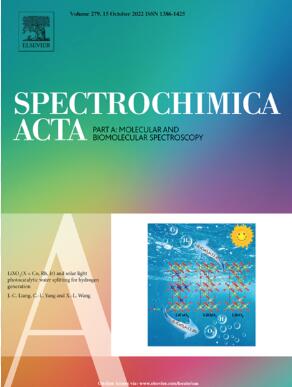Aggregation induced emission active pyrene scaffold for real-time chromogenic and fluorogenic selective detection of Pd2+ ion and device fabrication
IF 4.3
2区 化学
Q1 SPECTROSCOPY
Spectrochimica Acta Part A: Molecular and Biomolecular Spectroscopy
Pub Date : 2025-02-05
DOI:10.1016/j.saa.2025.125865
引用次数: 0
Abstract
A fluorogenic and chromogenic probe (L1) bearing pyrenyl and naphthyl group was synthesized using 4-(naphthalen-1-yl) thiosemicarbazide and pyrene-1-carboxaldehyde. Sensor (L1) exhibited significant Aggregation Induce Emission (AIE) property in 7:3 water-EtOH mixture and the aggregate exhibited a yellowish-green fluorescence upon excitation with 380 nm light. Upon adding Pd2+ ion, colourless EtOH/aqueous HEPES buffer (3:7, v/v) solution of L1 showed a sharp change to bright yellow as well as fluorescence turn off response. Probe displayed high selectivity, sensitivity, rapid response time (50 s) and good pH tolerance range (5–8). Sensing was reversed in presence of triphenylphosphine. The detection limit of Pd2+ was 41 nM (7.2 ppb) which was lower than the WHO recommended value. Mass spectrum and Job’s plot revealed 1:1 binding ratio. Both FESEM and DLS studies manifested the decrease of particle size of L1 upon interaction with Pd2+ ion. 1H NMR titration data were consistent with binding of Pd2+ to nitrogen atom of (![]() CH
CH![]() N
N![]() ) group and IR spectra revealed coordination by sulphur of carbothioamide group. DFT/TDDFT calculations performed on L1 and [Pd(L1)(NO3)2] supported the experimental results very well. Probe L1 was also found to be suitable for the recognition of Pd2+ in real water and pharmaceutical drug samples. Paper strips for on-spot analysis and testing and a symmetric 2D sensor device were also constructed.
) group and IR spectra revealed coordination by sulphur of carbothioamide group. DFT/TDDFT calculations performed on L1 and [Pd(L1)(NO3)2] supported the experimental results very well. Probe L1 was also found to be suitable for the recognition of Pd2+ in real water and pharmaceutical drug samples. Paper strips for on-spot analysis and testing and a symmetric 2D sensor device were also constructed.

求助全文
约1分钟内获得全文
求助全文
来源期刊
CiteScore
8.40
自引率
11.40%
发文量
1364
审稿时长
40 days
期刊介绍:
Spectrochimica Acta, Part A: Molecular and Biomolecular Spectroscopy (SAA) is an interdisciplinary journal which spans from basic to applied aspects of optical spectroscopy in chemistry, medicine, biology, and materials science.
The journal publishes original scientific papers that feature high-quality spectroscopic data and analysis. From the broad range of optical spectroscopies, the emphasis is on electronic, vibrational or rotational spectra of molecules, rather than on spectroscopy based on magnetic moments.
Criteria for publication in SAA are novelty, uniqueness, and outstanding quality. Routine applications of spectroscopic techniques and computational methods are not appropriate.
Topics of particular interest of Spectrochimica Acta Part A include, but are not limited to:
Spectroscopy and dynamics of bioanalytical, biomedical, environmental, and atmospheric sciences,
Novel experimental techniques or instrumentation for molecular spectroscopy,
Novel theoretical and computational methods,
Novel applications in photochemistry and photobiology,
Novel interpretational approaches as well as advances in data analysis based on electronic or vibrational spectroscopy.

 求助内容:
求助内容: 应助结果提醒方式:
应助结果提醒方式:


